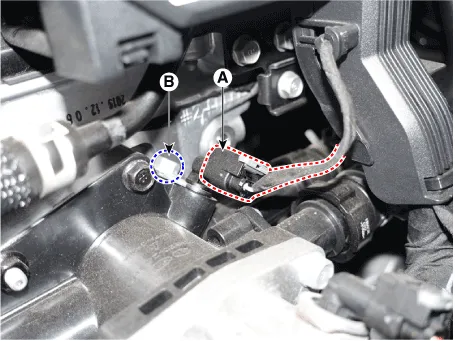Hyundai Santa Fe (TM): Engine Control System / Engine Coolant Temperature Sensor (ECTS). Repair procedures
| Inspection |
| 1. |
Turn the ignition switch OFF.
|
| 2. |
Disconnect the ECTS connector.
|
| 3. |
Remove the ECTS.
|
| 4. |
After immersing the thermistor of the sensor into engine coolant, measure
resistance between the ECTS terminals 3 and 4.
|
| 5. |
Check that the resistance is within the specification.
|
| Removal |
| 1. |
Turn the ignition switch OFF and disconnect the battery negative (-)
cable.
|
| 2. |
Remove the engine control module.
(Refer to Engine Control/Fuel System - "Engine Control Module (ECM)")
|
| 3. |
Disconnect the engine coolant temperature sensor connector (A).
|
| 4. |
Remove the installation bolts (B), and then remove the engine coolant
temperature sensor from the engine.
|
| 5. |
Supplement the engine coolant.
(Refer to Engine Mechanical System - "Coolant")
|
| Installation |
|
|
|
| 1. |
Installation is reverse of removal.
|
Circuit Diagram Harness Connector
Description Crankshaft Position Sensor (CKPS) detects the crankshaft position and is one of the most important sensors of the engine control system.
Other information:
Hyundai Santa Fe (TM) 2019-2023 Service and Repair Manual: Power Tailgate Module
Description and operation Description Power tailgate is an electro-mechanical system designed to provide power opening and closing of the tailgate through the push of a button of a remote key (fob), console switch, inner switch or an outside handle switch of the tailgate.
Hyundai Santa Fe (TM) 2019-2023 Service and Repair Manual: Auto Head Lamp Leveling Device
Components and components location Component Location 1. Head lamp leveling actuator Head Lamp Leveling Switch. Schematic diagrams Circuit diagram Head Lamp Leveling Switch. Repair procedures Inspection 1.
Categories
- Manuals Home
- Hyundai Santa Fe Owners Manual
- Hyundai Santa Fe Service Manual
- Engine Control/Fuel System
- Gauges and meters
- Restraint
- New on site
- Most important about car


